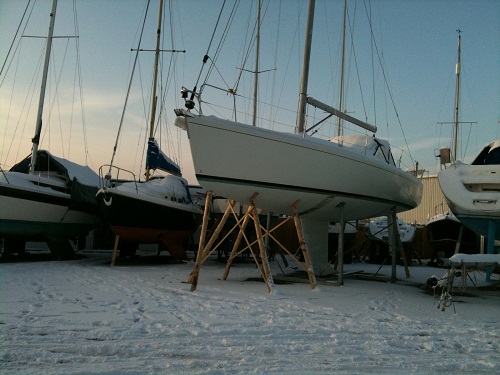The simplest way to protect your boat over winter is to take it out of the water and take steps to prevent damage from frost, rain, snow, high winds and damp. Detailed advice is available on boats.com in articles such as: Laying-up and winterisation tips, How to winterise an outboard engine and Prevent damp on your boat: a guide to dehumidifiers.
Unfortunately, however, many of us will spend the spring fixing all the things that went wrong during the off-season. So what else can go wrong? And how do you protect your boat over winter?
1. PREVENTING CHAFE
It’s actually possible to do more harm than good in an attempt to protect your boat over winter. When using the common blue tarpaulin for a winter cover, if you don’t put some sort of padding (such as a sheet or blanket) over an outboard’s cowl, and your tarp comes in contact with it, you’re in for trouble. Tarpaulins are abrasive, and when they billow in and out or shift in the wind, they’ll rub the shiny finish right off your outboard. True, there won’t be damage if you secure the tarp well enough that it doesn’t move, but that’s nearly impossible to do in anything over 20 knots. Either pad that cowl generously, or have the boat shrink-wrapped instead of covering it with a tarp. Note: this same type of issue can arise if the tarp comes in contact with shiny gel coat, and rubs your fibreglass the wrong way.
2. SINKING ON THE SLIP
Most boaters already know that the majority of sinkings occur in the slip. But you might not realize that close to 10 percent of those sinkings occur because water flowed in through a fitting that was above the waterline. How can water possibly come in from a fitting that’s not underwater? Snow, or blocked cockpit drains. Snow or trapped water adds weight, pushing the boat deeper and deeper into the water until… you get the picture.
The key to avoiding the sunk-in-the-slip disaster is twofold; constantly visiting your boat, especially right after a snow fall (obviously, after a heavy snow you may need to clear the decks), or rain fall, and making sure it has plenty of power either from shorepower or well-charged batteries, so the pumps will keep running if water does start coming in. Note: some manufacturers also recommend plugging the exhaust ports on an inboard-powered boat that spends all winter in the slip.
But snow isn’t the only trick up Old Man Winter’s sleeve. Another cold weather danger to boats stored in the water is bursting hoses. If water remains in a hose, it can freeze. True, in most regions boats in the water are less susceptible to freeze damage than those on land. But when temperatures plummet there is only one way to prevent a frozen pipe from flooding your boat: close all the seacocks, before the freezing temperatures set in. (And if your boat doesn’t have seacocks on all of the through-hulls below the waterline, it shouldn’t spend its winter in the water.)
3. COLLAPSING COVER SYNDROME
There are many types of boat cover still in use – and unless you’re the owner of a wooden boat – almost any method of protection from the elements is better than just leaving the decks exposed to the wind and weather. However, even shrink wrap can sometimes succumb to the weight of snow, standing water, leaves and the battering effects of wind. And if that cover collapses, your boat’s going to suddenly become exposed. Again, the main way you can defend against this issue is by consistently checking down at the yard, and making sure everything’s ship-shape. A collapsing cover may not be preventable but if you discover what’s gone wrong in a matter of days instead of weeks, you can make some quick repairs and minimise the damage.
4. BROKEN BACK
When boats are stored ashore and you don’t have a trailer, the job is usually left to the marina to haul and block the hull—as it should be. First because the professionals know how to do the job a lot better than the average boater, and secondly because any reputable marina will carry the appropriate insurance in case something goes wrong. That doesn’t mean, however, that you shouldn’t do a little checking up on the job they’ve done.
Naturally, the boat needs to be sufficiently blocked so it won’t fall over. Generally speaking, two stands per side is only sufficient up to about 26 feet. If your boat is bigger, additional jack stands should be in place. But most of the weight will be sitting on the boat’s keel, which should be supported by wood blocks. If not, your boat could suffer a broken back.
Even with blocks in place, damage is still a possibility. It’s important for the boat’s weight to be evenly distributed, and to prevent all the weight from settling in one area. Naturally, we expect that you eyeballed the boat after it was initially hauled and blocked. But did you go back and look again, two weeks later? Jack stands and blocks sometimes settle, especially after a hard rain, and this can cause shifts in the load. So once again, periodic check-ins through the winter are a key part of ensuring smiles, come spring.
5. FLAMING FIBREGLASS
A properly winterised boat should not need any heaters on board. According to insurance statistics heaters are one of the number-one reasons why boats stowed for the winter go up in flames.
Interestingly, the statistics also show that most freeze damage insurance claims in the USA are generated in places with relatively mild climates, like California. In such areas many boaters don’t consider winterising 100 per cent necessary. Bad move. If there’s any chance of freeze damage where you live, fully winterizing the boat is your best bet.
In the UK many boaters use dehumidifiers to keep moisture at bay below decks during the winter. The devices ‘inhale’ damp air, which is then circulated through refrigerated mesh, then ‘exhaled’ warmer and drier. They are less effective at temperatures below 6°C and many are completely ineffective below 4°C, but for the average UK winter, these can be useful devices on board.
BONUS TIP: If your boat is stored on a trailer somewhere that is likely to see heavy snowfall, make sure it isn’t parked next to a building with a sloped roof. Otherwise, snow could avalanche right onto your boat and cause some serious damage.




















